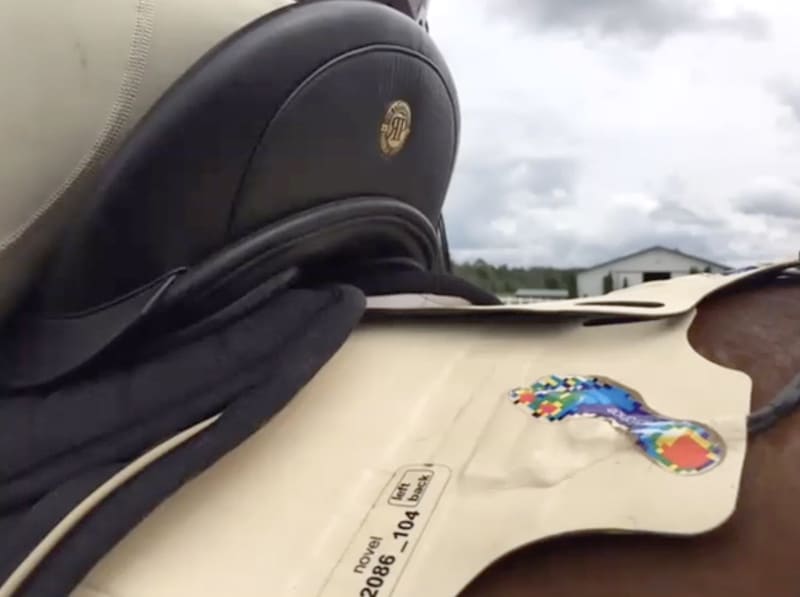Sienna Stanton, a student at Michigan State University College of Veterinary Medicine and long-time hunter-jumper rider wants to know: “Are we inflicting a higher incidence of back pain and back-pain-associated lameness by asking these horses to carry us over fences? Because that could have both performance- and potentially even welfare-related implications.”
Stanton is lead author of “Forces exerted on the back during jumping,” a study she presented at the 2021 Equine Science Society Virtual Symposium, earlier this summer. She notes several studies have investigated how saddle fit correlates to back soreness and others that have assessed forces on the back while standing and at walk, trot and canter.
“Jumping a fence while carrying a rider is a significant component of that horse-saddle-rider interaction within the hunter-jumper discipline specifically that still requires some exploration,” says Stanton.
Her research objective was to compare the pressure on a horse’s back during three phases of a jump – takeoff, flight and landing – at two jump heights, 84- and one-metre. Stanton and her colleagues at the university’s pathobiology and diagnostic investigation laboratory hypothesized the pressure would be greater over the higher jump and during the landing phase.

Data for the mean and peak pressure was taken in kilopascals from the whole, front and back of the pliance-s mat that was situated under the rider’s regular saddle and pad. (Sienna Stanton photo)
Five horses, ridden by their owners, were outfitted with a (commercially available) thin pliance-s pressure distribution sensor mat below their usual saddle and pad. Data was collected at the canter for baseline measurement to control for differences between horse-rider combinations and saddle fit and then over jumps. It was synchronized with video and divided into takeoff, flight and landing phases for analysis.
Data for the mean (average) and peak pressure was taken in kilopascals (kPa) from the whole, front and back of the mat. The pressure at each phase was normalized (adjusted to make variables comparable to each other) to the baseline canter measurements and statistically interpreted.
Ultimately, Stanton and her colleagues saw no difference in pressure between jump heights, which, “wasn’t exactly what we expected based on our hypothesis.” She suggests this might have been because the heights were too similar at only 16 centimetres, or six inches, apart.
Peak, but not mean, pressures, were generally greatest on landing. The only exception was that mean pressures in the saddle’s front zone were also greatest on landing.
“Considering that the back of the pad didn’t also follow that model, it could be suggested that the majority of the landing force is concentrated over the pommel area of the saddle, which really makes sense when considering the angle of horse and rider upon landing.”
Referring to a 2005 paper indicating a correlation between back pain and peak pressure values greater than 31.5 kPa in the front part of the saddle with the rider at the sitting trot, Stanton says the average peak landing pressure of 51 kPa in her study “was well above that threshold.” For reference, she says, that’s approximately the pressure of an inflated standard women’s basketball.
She also notes bed sores develop in humans with pressures above 4.26 kPa. While horses are more tolerant, by just how much she asks? “Is it due to the more dynamic pressure relationship between the horse and saddle during movement or is it just simply because they don’t have those pressures sustained all day like a bedridden human patient would?”
And what situation causes more damage Stanton queries? The lower sustained pressures of a long, perhaps less intense ride, or even having a saddle on for significant portion of a day such as at a horse show versus brief, high intensity, “almost cyclic forces” of jumping a course of fences?
A 2012 review she cites concludes back pain causes changes in the neuromotor control of the stabilizing musculature surrounding the spine that can cause arthritic changes over time. If we know we are causing a horse some degree of back pain, muscle atrophy and resulting changes in horse-saddle-rider interaction, “would giving a couple days of rest post-jumping help to break that cycle?” she ponders.
The study was limited by the low number of horses involved. And, because they were higher-end show mounts, the owners preferred to ride the animals themselves versus using one standard rider for all the rides, But, says Stanton, researchers combatted that to the best of their ability by normalizing the data to the baseline canter.
During data collection, one horse refused a fence. Interestingly, the peak pressure observed in the front saddle zone was 99.6 kPa. To combat the abrupt stop in forward motion, the rider must focus their weight in the stirrups or the pommel.
“You have to ask,” says Stanton, “how much is poor riding or untrained horses contributing to the back lameness that we’re seeing in hunter-jumpers?”
Finally, she notes that only “good” takeoff distances were assessed in the study and that forces on the back could possibly change with poor distances that affect horse-rider-saddle interaction and form over the fence.
Further study is warranted, says Stanton, to aid in the prevention and treatment of back pain related lameness and performance issues in hunter-jumpers.

